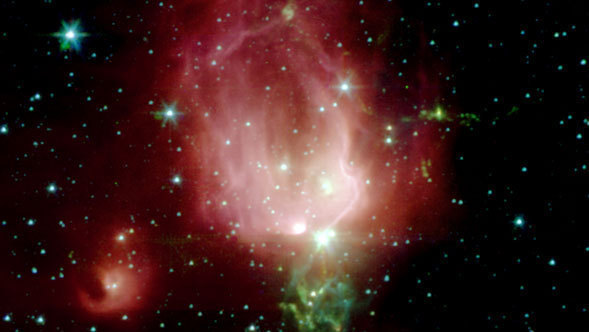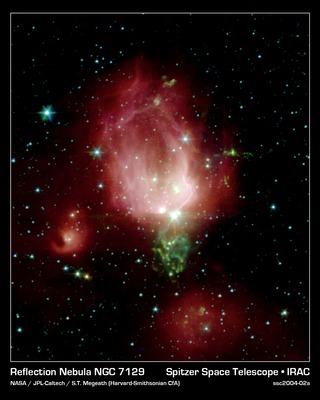
News Release • February 12th, 2004 • ssc2004-02 •
Out of the dark and dusty cosmos comes an unusual valentine -- a stellar nursery resembling a shimmering pink rosebud. This cluster of newborn stars, called a reflection nebula, was captured by state-of-the-art infrared detectors onboard NASA's new Spitzer Space Telescope, formerly known as the Space Infrared Telescope Facility.
"The picture is more than just pretty," said Dr. Thomas Megeath, principal investigator for the latest observations and an astronomer at the Harvard Smithsonian Center for Astrophysics, Cambridge, Mass. "It helps us understand how stars form in the crowded environments of stellar nurseries."
Located 3,330 light-years away in the constellation Cepheus and spanning 10 light-years across, the rosebud-shaped nebula, numbered NGC 7129, is home to some 130 young stars. Our own Sun is believed to have grown up in a similar family setting.
Previous images of NGC 7129 taken by visible telescopes show a smattering of hazy stars spotted against a luminescent cloud. Spitzer, by sensing the infrared radiation or heat of the cluster, produces a much more detailed snapshot. Highlighted in false colors are the hot dust particles and gases, respectively, which form a nest around the stars. The pink rosebud contains adolescent stars that blew away blankets of hot dust, while the green stem holds newborn stars whose jets torched surrounding gases.
Outside of the primary nebula, younger proto-stars can also be seen for the first time. "We can now see a few stars beyond the nebula that were previously hidden in the dark cloud," said Megeath.
In addition, the findings go beyond what can be seen in the image. By analyzing the amount and type of infrared light emitted by nearly every star in the cluster, scientists were able to determine which ones support the swirling rings of debris, called circumstellar discs, which eventually coalesce to form planets. Roughly half of the stars observed were found to harbor discs.
These observations will ultimately help astronomers determine how stellar nurseries shape the development of planetary systems similar to our own.
Launched on August 25, 2003, from Cape Canaveral Air Force Station, Florida, the Spitzer Space Telescope is the fourth of NASA's Great Observatories, a program that also includes the Compton Gamma Ray Observatory, Chandra X-ray Observatory and Hubble Space Telescope.
JPL manages the Spitzer Space Telescope mission for NASA's Office of Space Science, Washington. Science operations are conducted at the Spitzer Science Center at the California Institute of Technology in Pasadena. JPL is a division of Caltech.
News Media Contact
Whitney Clavin
(626) 395-1877
Jet Propulsion Laboratory, Pasadena, Calif.





